|

Published
monthly for CC employees by Clinical Center Communications
past
issues
September
2000
New
system a first step toward filmless radiology
NIH mourns death of compassionate clinician, innovative thinker
Resource fair focuses on real choices for real people
Vaccine supply to foil the flu now uncertain
Medicine for the Public begins Sept. 19
Life-long love of sports brings CC rabbi
to stage of baseball documentary
List of Spanish-language education materials grows
Neuroscience nurse internship graduates
Neuroscience nurse internship graduates
News
briefs
|
|
The CC Imaging Sciences
Program (ISP) will unveil the first phase of its new Picture Archiving
and Communication System (PACS) and Radiology Information System (RIS)
this month with the initiation of a sophisticated patient tracking system.
PACS is a high-speed,
digital system for acquiring, storing, processing, and displaying images
and reports. It will provide instant electronic access to current and
past diagnostic images. RIS performs patient tracking and imaging-exam
monitoring functions.
"This system will
completely reengineer the operations of the radiology department," said
Jim Vucich, ISP manager and PACS/RIS project co-manager. "We expect it
to increase the quality and efficiency of radiology services by reducing
patient waiting times, improving image availability, and minimizing loss
and misidentification of images and reports," he said.
RIS is the first part
of the system to be installed and will go on line for testing this month.
"For the first two or three months, we will still be maintaining data
in paper form," explained Vucich. PACS is scheduled to begin operating
within ISP in October and throughout NIH by next summer.
RIS will track patient
arrival and departure times, the start and end of exams, and when reports
are dictated, read, and signed. Eventually, the system will include a
voice recognition feature enabling spoken words to appear on the screen
so reports can be immediately edited and verified. It also communicates
with the medical information system (MIS) to receive orders for exams
and send reports on completed exams back to the appropriate destinations.
Images stored in PACS/RIS
originate from procedures and exams conducted in the Diagnostic Radiology,
Nuclear Medicine, and PET Departments. They include CT scans, MR scans,
PET scans, nuclear medicine scans, ultrasound examinations, and digital
radiography examinations.
When an order for an
imaging procedure is entered into MIS, the order will automatically be
sent to RIS. The system will then track when the patient transport was
called, when the transport left to transfer the patient, when the patient
arrived in the radiology department, and when the patient entered and
left locations within the department. "Such detailed data will decrease
patient waiting times and make better use of staff and equipment," Vucich
said.
Once an order for an
imaging procedure is placed in the system, PACS/RIS will automatically
retrieve prior scans and reports for that patient. The system integrates
new and prior images and reports, so physicians can access and compare
current images with previous scans and x-rays. "This will make radiology
images and reports more easily accessed by physicians, including after
hours," said Dr. Alberto Goldszal, chief, PACS/RIS section and PACS/RIS
project co-manager. It is customized to track images by protocol and institute.
Radiologists will
interpret images on large, high-resolution monitors in the Diagnostic
Radiology Department. When the system is fully deployed next summer, patient
images and their corresponding reports will be available on workstations
and desktop computers across NIH through the use of the PACS web browser
application. In addition, workstations dedicated to PACS/RIS image and
report reviewing will be installed in specialized areas of the CC that
conduct intensive image review activities. The images and reports will
only be available to authorized users.
"This is the first
step toward a filmless radiology department," explained Vucich. "Eventually
all images will be acquired, distributed, and stored in digital form.
This will eliminate film and processing costs as well as lost and damaged
films." "We expect this system to prove to be an efficient method for
connecting people to the knowledge and resources they need at the appropriate
times and locations for the best possible outcomes," concluded Dr. Goldszal.
--by Colleen Henrichsen
|
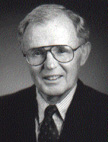 NIH
mourns death of compassionate clinician, innovative thinker
NIH
mourns death of compassionate clinician, innovative thinker
Dr. John Leo Doppman, 72,
chief of the CC Diagnostic Radiology Department for 26 years, died of cancer
on Aug. 21 at the Clinical Center. A diagnostic and interventional radiologist
here for 36 years, Dr. Doppman retired in April.
Dr. Doppman developed, refined,
and performed numerous semi-surgical radiologic procedures. He was a pioneer
in angiography, a technique that uses injections of radio-opaque dye to visualize
blood vessels and tumors. He researched vascular malformations of the spinal
cord and developed ways to visualize and treat them. His research culminated
in the publication of the first text on this subject in 1969. Later, he concentrated
on endocrinology research and developed techniques for locating ectopic or elusive
glandular tumors. Many of these techniques are now standard practice in medical
centers worldwide.
"John was a pillar
of the NIH clinical research community," said Dr. John Gallin, Clinical
Center director. "He was a respected clinician, prolific writer, dedicated
teacher and generous friend. He will be missed."
Dr. Doppman received an MD
from Yale and interned at Mercy Hospital, Springfield, Mass., served in the
Navy from 1954 to 1957 and completed a residency in radiology at the Hospital
of St. Raphael, New Haven, Conn. He was a Fullbright Fellow in radiology research
at the Postgraduate Medical School at Hammersmith Hospital, London, and the
Karolinska Institute, Stockholm.
He joined the NIH Clinical
Center in 1964 as deputy chief of the Diagnostic Radiology Department. From
1970-1972 he was a radiology professor at the University of California, San
Diego. He returned to NIH where he was chief of the Clinical Center Diagnostic
Radiology Department from 1972-1996. Under his direction the department acquired
among the first CT and MRI scanners in the country.
"He was a keen, compassionate
clinician, an enthusiastic teacher, and an innovative thinker," said Dr.
Andrew Dwyer, CC radiologist. "He was a strong, positive influence on the
clinical, educational and research environment of the Clinical Center."
On Aug. 2, Dr. Doppman was
awarded scientist emeritus status. Among his many honors were the Gold Medal
from the Society of Cardiovascular and Interventional Radiology (1997); Gold
Medal from the American Roentgen Ray Society (1998); the Copeland Award from
M.D. Anderson Cancer Center (1992); and the Public Health Service Distinguished
Service Medal (1982), the highest award granted by PHS. He also received several
NIH awards including the Distinguished Clinical Teacher Award (1997); the Clinical
Center Director's Award (1997); and the NIH Director's Award (1999).
He was an honorary member
of the radiological societies of England, Ireland, Germany, and Hungary, as
well as of the American Society of Endocrine Surgeons. He authored 38 textbook
chapters and 516 articles in scientific journals.
Survivors include his wife,
Anne-Marie; a daughter, Corinna, a son, Christopher; and a granddaughter, Nicole.
Resource
fair focuses on real choices for real people
|
|
WHEN: Thursday, October
5 10 a.m. to 3 p.m.
WHERE: Building 10 Visitor Information Center (lower level exhibit area)
Linda Breen Pierce,
author of "Choosing Simplicity: Real People Finding Peace & Fulfillment
in a Complex World," will speak at noon in Lipsett Amphitheater.
For further information,
please call the Work and Family Life Center at 5-1619.
On the web: http://wflc.od.nih.gov
|
If you're looking for an
easier way to balance the demands of work, home, and your personal needs, look
to the NIH Quality of Work Life Committee. They'll sponsor a resource fair
--Real People, Real Choices: Quality of Work Life at NIH--Oct. 5 at the Clinical
Center.
NIH is dedicated to quality
of work life, and a wide variety of resources are available to help you navigate
the complexities of modern life, planners note. The fair will provide an opportunity
to learn more about employee services here. Twenty-six NIH offices and organizations,
including the CC QWL Council, will be on hand showcasing programs that help
enhance quality of life. At the fair you will be able to stop by and talk to
representatives from services here than may help address your concerns and questions.
For instance, you can:
- learn all about the CC
QWL Council
- find out more about NIH's
family friendly workplace policies
- talk to on-campus child
care centers about programs and availabilit
- find out about child
care and elder care resource and referral services
- hear about health and
wellness at NIH
- find out about programs
that make the campus safe
- get information about
R&W;'s new concierge service
- find out about the wealth
of training and development programs here
- learn about alternative
dispute resolution
- get in touch with the
resources you need find a work-life balance
 Medicine
for the Public begins Sept. 19
Medicine
for the Public begins Sept. 19
The Medicine for the Public
lecture series begins Sept. 19. The lectures are held at 7 p.m. on Tuesdays
in the Clinical Center's Masur Auditorium.
The schedule: Sept. 19, New
Directions for Organ and Tissue Transplantation, Dr. Allan Kirk, NIDDK. Sept.
26, Adolescents and AIDS: Millennium Milestones, Dr. Lauren Wood, NCI. Oct.
3, Dangerous Liaisons: Drugs and Herbal Products, Dr. Stephen Piscitelli and
Dr. Aaron Burstein, CC. Oct. 10, Stroke: Rapid Diagnosis, New Treatments, Dr.
Alison Baird, NINDS. Oct. 17, Women's Health Research for the 21st Century,
Dr. Vivian Pinn, Office of Research on Women's Health. Oct. 24, Prostate Cancer,
Dr. Marston Linehan and Dr. William Dahut, NCI.
On the web: http://www.
cc.nih.gov/ccc/mfp/series.html
Vaccine
supply to foil the flu now uncertain
The Centers for Disease Control
and Prevention's (CDC) recent announcement that distribution of this year's
influenza vaccine may be substantially delayed--and amounts delivered smaller
than usual--could affect flu immunization practices at the Clinical Center.
Typically, the CC provides "Foil the Flu" vaccinations beginning in
mid-October, but at press time, the delivery date and number of doses that the
CC will receive had not yet been established. The Occupational Medical Service
and the Hospital Epidemiology Service will publicize information on this year's
influenza vaccine program as soon as more specifics are available. As always,
CC patients and the staff caring for them will be the first to receive immunizations.
In the United States, flu season peaks between late December and early March.
Mid-October vaccination is the best way to minimize serious adverse outcomes
from influenza virus infection.
On the web: http://www.cdc.gov/nip
and http://www.cdc.gov/epo/mmwr/preview/mmwrhtml/rr4903a1.htm
|
|
Life-long
love of sports brings CC rabbi
to stage of baseball documentary
You might have the
chance to see someone on the movie screen that you know and work with
every day.
"The Life and
Times of Hank Greenberg," a documentary detailing the major league
baseball player's life, features an appearance by CC Jewish chaplain Rabbi
Reeve Brenner.
Dr. Brenner, who joined
NIH part-time this past January, says that three factors converged to
lead to his screen debut. First, he grew up in New York City, also home
to Hank Greenberg, who Dr. Brenner regards as the all-time greatest Jewish
player in the major league. Second, he is a life-long sports enthusiast,
and last as a religious leader and teacher, he likes to think and write
about ethical issues.
It was Dr. Brenners
handling of delicate issues, such as race and religion, that captured
the attention of the film's writer-producer, Aviva Kempner. In his article,
"Black Jack and Big Yid Greenberg," which first appeared almost
20 years ago in the Jewish Spectator newspaper, Dr. Brenner focused on
the crossing paths of the two baseball giants, referred to by nicknames
used by young Bronx baseball fans.
Greenberg was nearing
the end of his major league career. Jackie Robinson was just starting
his career as the first black baseball player to reach the major leagues.
Greenberg, who had experienced much anti-Semitism in a decade as a public
figure, was the first on his team to befriend and encourage Robinson,
similarly a target of racial prejudice.
"Having written
books, short stories, and sermons on just this issue, it was logical for
me to do the article that led to my being chosen for the film," said
Dr. Brenner. "I welcomed the opportunity to talk about an exemplary
man, and in particular on the very special Greenberg-Robinson meeting."
--by Linda Silversmith
|
|
|
|
Excerpt
from Dr. Brenner's article "Black Jack and Big Yid Greenberg"
published in the Jewish Spectator:
"But
that first game and that first circumstance which brought Hank and Jackie
togetherÑat a crucial point in the beginning of the post-Holocaust, post-World
War era of awakening to the havoc wrought by hatred and evilÑwitnessed
a meeting of giants engaged in the reaffirmation of decency among all
the peoples and races of humanity."
|
List
of Spanish-language education materials grows
Patients come to the Clinical
Center from all over the world. And for years, interpreters and bilingual staff
have helped bridge the gap between patients who do not speak English and caregivers
that do. Now, patient education materials will offer both patients and their
caregivers more common ground for communicating.
The CC patient education
publication website houses a growing library of documents in Spanish. Titles
include: Giving a Subcutaneous Injection; Managing Your Hickman Catheter; Managing
Your PICC/SICC Catheter; Infection Control at the Clinical Center: Information
for Patients and Visitors; Hello: I'm Your Primary Nurse; Preparing for Outpatient
Surgery; Preparing for Transfusion Therapy; Partners in Research--Volunteer
Patients and the NIH Clinical Center; Working Together to Relieve Your Pain;
and the Living with Cancer Chemotherapy series.
The website also has a bilingual
document, "Spanish Phrases for Health Professionals," and a Spanish-language
version of the patient handbook. For more information on patient education materials,
contact Wendy Schubert at 6-2563 (e-mail wschubert@nih.gov).
For assistance with language interpreting services, contact Andrea Rander, director
of volunteers, at 6-1807 (e-mail arander@nih.gov).
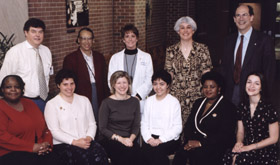 |
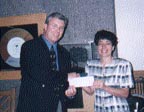 |
|
Neuroscience nurse
internship graduates
Six registered nurses
recently completed the CC Nursing Department's Neuroscience Nurse Internship
Program, a six-month clinical internship program designed to prepare new
nursing employees to provide care for patients with neurological disorders
or cancer. Shown front row are graduates, all RNs, (left to right) Sandra
Brown, Dana Menkin, Jenifer Tennant Dwyer, Ruby Lerner, Justina Ezejiofor,
and Judith Resick. In back is the Neuroscience Leadership Team: (left
to right) Dr. Jacques Bolle, R.N., CC; Dr. Audrey Penn, M.D., NINDS; Anita
Marban, R.N., CC; Beth Price, R.N., CC; and Dr. Mark Hallett, NINDS.
|
NIH police fundraiser
benefits FOCC
The NIH Police's recent
"Police Week" iincluded a fundraising barbecue to benefit the
Friends of the Clinical Center. More than 1500 people attended the gathering,
which was held in front of Bldg. 1 and featured traditional cookout delectables
prepared by NIH Police staff. On hand for the presentation of the donation
were (left to right) Kip Fenton, FOCC administrative assistant; O.W. Jim
Sweat, director of the Division of Public Safety; NIH Police Captain Lawrence
Brown, Deputy Chief Robert Fuller, and Police Chief Alvin Hinton; and
Maria Stagnitto, FOCC president.
|
News
briefs
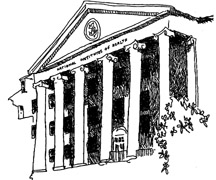 Orientation
Fair for NIH Trainees
Orientation
Fair for NIH Trainees
Bring your questions to the Orientation Fair for NIH Trainees set for Sept.
19 at the Clinical Center. Sponsored by the NIH Office of Education, the event
will be outside the Visitor Information Center 10 a.m. to 2 p.m. Slated to be
on hand are representatives from the NIH Library, the Office of Animal Care
and Use, the NIH Credit Union, the Work and Family Life Center, and the R&W.;
For details, call 6-2427.
Women's health seminar
topic
FAES will sponsor a new course, "Work, Women, and Health," beginning
Thursday, Sept. 21, at 5:30 p.m. This weekly seminar will cover women's health
research. Topics will include a presentation on the role of stress in disease,
a discussion of the structural biases that women face in the workplace, and
an open discussion with class participants. To register, call 6-7976. On the
web: http://www.faes.org
Interpreters needed
CC patients not fluent in English may have a hard time finding their way through
visits here. Volunteer interpreters often make things easier by stepping in
and helping with language translations. CC volunteer services is currently recruiting
individuals who are fluent in Korean, Japanese, Vietnamese, Spanish, French,
Arabic, and Farsi. For more information, call 6-1807.
DTM presents annual symposium
The CC Department of Transfusion Medicine, will host its Nineteenth Annual Symposium,
"Immunohematology and Blood Transfusion," on Sept. 14 from 8 a.m.
to 4:30 p.m. in Masur Auditorium. On the web:
http://www.cc.nih.gov/dtm
Heart disease study opens
A study of Heart Disease Risk Factors in African Americans seeks participants
to study the relationship between obesity and heart disease risk factors in
healthy, nondiabetic African-American men and pre-menopausal women. Participants
can be of any weight, from normal to obese, and between the ages of 18 and 50.
It will involve four outpatient visits to the Clinical Center, in which participants
will have body fat analyses; an electrocardiogram; blood tests, including cholesterol
profiles; and oral and intravenous glucose tolerance tests. All participants
will be compensated. For more information, call 2-7119.
Volunteers sought
CC researchers seek adults with sickle cell anemia to help find ways to understand
and treat the disease. Compensation will be provided. Call 1-800-411-1222, or
5-2345, for more information.
Resource offered
You've just received an important e-mail with a file to use in your upcoming
presentation. Unfortunately, your computer can't open the document. Don't fret,
the CC Information Technology Center can help. Located in Room 1C282, the center
is equipped with color scanning and printing devices, slide makers, computers,
and other helpful equipment. For more information, call 2-6301.
NIH to share the health
Oct. 21
The public is invited to NIH 8:30 a.m. to 3 p.m. for the third annual community
health forum, sponsored by the NIH Office of Community Liaison. The event features
free health-related information, exhibits by NIH institutes, lectures, health
screenings, and demonstrations. For more information, call 301-650-8660.
|
| Acting
Editor: Sara Byars |
Staff
Writers: Dina Dariotis, Bonnie Flock, LaTonya Kittles, Linda Silversmith
|
Clinical
Center News, 6100 Executive Blvd., Suite 3C01, MSC 7511, National Institutes
of Health, Bethesda, MD 20892-7511. Tel: 301-496-2563. Fax: 301-402-2984.
Published monthly for CC employees by the Office of Clinical Center Communications,
Colleen Henrichsen, chief. News, article ideas, calendar events, letters,
and photographs are welcome. Deadline for submissions is the second Monday
of each month.
index |



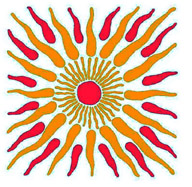
 Medicine
for the Public begins Sept. 19
Medicine
for the Public begins Sept. 19 Orientation
Fair for NIH Trainees
Orientation
Fair for NIH Trainees